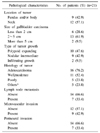Abstract
Purpose
Despite advances in imaging techniques, laparoscopic cholecystectomy (LC) gives many advantages to some patients with suspected gallbladder cancer. The aim of this study was to investigate clinicopathological features and to analyze the risk factors of recurrence after radical reresection for T2 gallbladder cancer patients diagnosed following LC.
Methods
From January 2002 to December 2009, the data of 21 consecutive patients for radical reresection for T2 gallbladder cancer were reviewed, retrospectively. The significance of the variables for recurrence was examined by the Kaplan-Meier method and log-rank test followed by multivariate analyses using Cox's proportional hazard model.
Results
Of the 21 patients studied, 11 were men and 10 were women. Lymph node metastasis was present in 7 patients (33.4%). The 5-year survival rate and disease-free survival rate in those patients were 75.3% and 67.9%, respectively. In the univariate analysis, the male gender (P=0.0047), poorly differentiated tumor (P=0.0169), presence of lymph node metastasis (P=0.0012), presence of lymphovascular invasion (P=0.0259) and presence of perineural invasion (P=0.0096) were significant factors related to recurrence after radical reresection. In the multivariate analysis, the presence of lymph node metastasis was an independently significant factor (5-year disease free survival rate, 20.9% vs. 83.8% in the absence of lymph node metastasis; P=0.015).
Figures and Tables
Fig. 1
(A) Overall survival rates in patients with T2 gallbladder carcinoma undergone radical reresection following laparoscopic cholecystectomy. (B) Disease free survival rates in patients with T2 gallbladder carcinoma undergone radical reresection following laparoscopic cholecystectomy.

Fig. 2
Disease free survival rates in patients with T2 gallbladder carcinoma undergone radical reresection following laparoscopic cholecystectomy according to presence of lymph node metastasis. P<0.05 by the log-rank test.

Table 1
Clinical characterisitics of T2 gallbladder cancer patients having undergone radical reresection

Table 2
Pathologic characteristics of T2 gallbladder cancer patients having undergone radical reresection

References
1. Jang JY, Kim SW, Lee SE, Hwang DW, Kim EJ, Lee JY, et al. Differential diagnostic and staging accuracies of high resolution ultrasonography, endoscopic ultrasonography, and multidetector computed tomography for gallbladder polypoid lesions and gallbladder cancer. Ann Surg. 2009. 250:943–949.
2. Chijiiwa K, Tanaka M. Indications for and limitations of extended cholecystectomy in the treatment of carcinoma of the gall bladder. Eur J Surg. 1996. 162:211–216.
3. Toyonaga T, Chijiiwa K, Nakano K, Noshiro H, Yamaguchi K, Sada M, et al. Completion radical surgery after cholecystectomy for accidentally undiagnosed gallbladder carcinoma. World J Surg. 2003. 27:266–271.
4. Akatsu T, Ueda M, Shimazu M, Wakabayashi G, Aiura K, Tanabe M, et al. Long-term survival of patients with gallbladder cancer detected during or after laparoscopic cholecystectomy. World J Surg. 2005. 29:1106–1109.
5. Yeh CN, Jan YY, Chen MF. Management of unsuspected gallbladder carcinoma discovered during or following laparoscopic cholecystectomy. Am Surg. 2004. 70:256–258.
6. Edge SB, Byrd DR, Campton CC, Fritz AG, Greene FL, Trotti A. AJCC Cancer Staging Manual. 2009. 7th ed. New York: Springer.
7. Chijiiwa K, Nakano K, Ueda J, Noshiro H, Nagai E, Yamaguchi K, et al. Surgical treatment of patients with T2 gallbladder carcinoma invading the subserosal layer. J Am Coll Surg. 2001. 192:600–607.
8. Shih SP, Schulick RD, Cameron JL, Lillemoe KD, Pitt HA, Choti MA, et al. Gallbladder cancer: the role of laparoscopy and radical resection. Ann Surg. 2007. 245:893–901.
9. Sikora SS, Singh RK. Surgical strategies in patients with gallbladder cancer: nihilism to optimism. J Surg Oncol. 2006. 93:670–681.
10. Shirai Y, Yoshida K, Tsukada K, Muto T. Inapparent carcinoma of the gallbladder. An appraisal of a radical second operation after simple cholecystectomy. Ann Surg. 1992. 215:326–331.
11. Choi ST, Hwang S, Lee SG, Lee YJ, Park KM, Kim KH, et al. Prognosis of patients with the gallbladder carcinoma undergone laparoscopic cholecystectomy as an initial operation. J Korean Surg Soc. 2003. 65:140–144.
12. Wakai T, Shirai Y, Hatakeyama K. Radical second resection provides survival benefit for patients with T2 gallbladder carcinoma first discovered after laparoscopic cholecystectomy. World J Surg. 2002. 26:867–871.
13. Ouchi K, Mikuni J, Kakugawa Y. Laparoscopic cholecystectomy for gallbladder carcinoma: results of a Japanese survey of 498 patients. J Hepatobiliary Pancreat Surg. 2002. 9:256–260.
14. Weiland ST, Mahvi DM, Niederhuber JE, Heisey DM, Chicks DS, Rikkers LF. Should suspected early gallbladder cancer be treated laparoscopically? J Gastrointest Surg. 2002. 6:50–56.
15. Braghetto I, Bastias J, Csendes A, Chiong H, Compan A, Valladares H, et al. Gallbladder carcinoma during laparoscopic cholecystectomy: is it associated with bad prognosis? Int Surg. 1999. 84:344–349.
16. Paolucci V, Schaeff B, Schneider M, Gutt C. Tumor seeding following laparoscopy: international survey. World J Surg. 1999. 23:989–995.
17. Shukla PJ, Barreto G, Kakade A, Shrikhande SV. Revision surgery for incidental gallbladder cancer: factors influencing operability and further evidence for T1b tumours. HPB (Oxford). 2008. 10:43–47.
18. Muratore A, Amisano M, Vigano L, Massucco P, Capussotti L. Gallbladder cancer invading the perimuscular connective tissue: results of reresection after prior non-curative operation. J Surg Oncol. 2003. 83:212–215.
19. Aoki T, Tsuchida A, Kasuya K, Inoue K, Saito H, Koyanagi Y. Is frozen section effective for diagnosis of unsuspected gallbladder cancer during laparoscopic cholecystectomy? Surg Endosc. 2002. 16:197–200.
20. Glenn F. Glenn F, editor. Radical cholecystectomy for carcinoma of the gallbladder. Atlas of Biliary Tract Surgery. 1963. New York: Macmillan;86–89.
21. Bartlett DL, Fong Y. Blumgart LH, Fong Y, Jarnagin WR, editors. Gallbladder cancer. Hepatobiliary Cancer. 2001. Hamilton: B.C. Decker;211–222. (Atlas clinical oncology).
22. Lee JY, Seo HI, Sim MS. The efficacy of simple cholecystectomy among patients with T2 gallbladder cancer. J Korean Surg Soc. 2009. 76:316–320.
23. Suzuki S, Yokoi Y, Kurachi K, Inaba K, Ota S, Azuma M, et al. Appraisal of surgical treatment for pT2 gallbladder carcinomas. World J Surg. 2004. 28:160–165.
24. Aramaki M, Matsumoto T, Shibata K, Himeno Y, Yada K, Hirano S, et al. Factors influencing recurrence after surgical treatment for T2 gallbladder carcinoma. Hepatogastroenterology. 2004. 51:1609–1611.
25. Yeu KJ, Choi JW, Lee DS, Kim HJ. Should the extrahepatic bile duct be resected for T2 gallbladder cancer? J Korean Surg Soc. 2009. 77:113–119.




 PDF
PDF ePub
ePub Citation
Citation Print
Print




 XML Download
XML Download